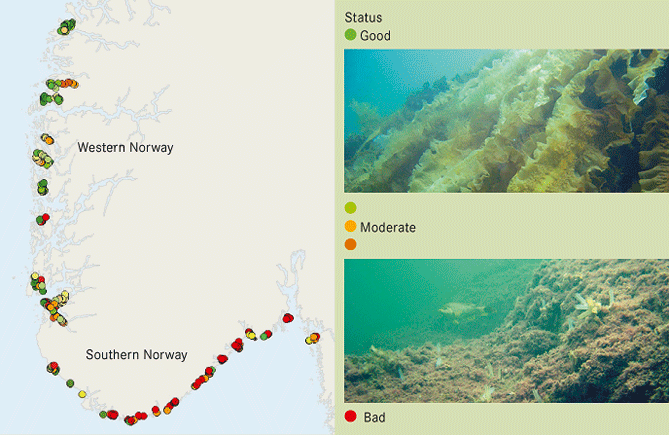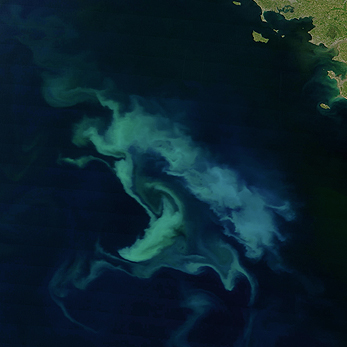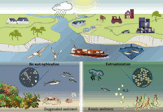Eutrophication affects marine ecosystems in many ways
Eutrophication is mainly a problem in coastal areas and in areas with restricted water exchange, such as enclosed estuaries and embayments. Eutrophication causes changes in the composition of plant and animal communities and generally favours growth of rapidly reproducing opportunistic algal and animal species Figure 4.1. Opportunistic algal species do not always pose a threat but some species can adversely affect ecosystems. Mass occurrence of phytoplankton also reduces the depth at which light is available for long-lived seagrass species. Once the nutrients have been depleted, the algal blooms associated with nutrient enrichment decay, leading to oxygen deficiency and possibly kills of fish and benthic invertebrates, and to the formation of toxic hydrogen sulphide (H2S).
As well as causing impacts on the ecosystem, eutrophication can affect human activities. For example, algal blooms can clog fishing nets. Decaying blooms of some algae can create unsightly foam masses on beaches and unpleasant smells that interfere with tourism and recreation. Although some algae produce toxins that can harm humans through consumption of contaminated shellfish, the link to nutrient enrichment is uncertain.
Excess nutrients result from sources on land and at sea
Rivers are the main pathway for excess nutrients to Regions II, III and IV, collecting direct discharges from point sources, such as sewage treatment plants and industry, and inputs from land run-off and leaching, mainly as a result of agriculture. The amounts of nutrients released from land-based sources vary according to land use and population density. Point sources generally dominate in urban areas, while diffuse sources dominate in farming areas. Farmland covers about half the total land area in many OSPAR countries, reaching 60% to 70% for some countries bordering Regions II and III. The rate of turnover of nutrients in soils and sediments means they can be released to the marine environment for decades after releases from the original sources have been reduced. A further potential confounding factor is hazardous substances, some of which (e.g. certain anti-fouling agents) have the potential to influence algal growth and in turn eutrophication effects. Transboundary transport of nutrients by ocean currents is particularly important in Region II.
Atmospheric deposition is an important pathway for nitrogen to the sea and is usually greatest close to the source. Nitrogen is emitted to the atmosphere from agriculture and from combustion processes associated with industry and transport, including maritime shipping, and can be carried by winds to places far from the emission sources, where it is deposited. In Regions I and V, far from most point sources of pollution, atmospheric deposition is the main pathway for anthropogenic inputs of nitrogen.
Climate change may alter impacts
More rain and increased flooding as a result of climate change are expected to enhance nutrient enrichment through increased freshwater input and run-off from land Chapter 3. Rising sea temperature and prolonged stratification are likely to lead to increased incidence of harmful algal blooms and changing phytoplankton composition. Ocean acidification may also promote changes in the plankton. Recent observations of the decline in sugar kelp along the southern coast of Norway indicate possible interactions between climate change and eutrophication. Improved understanding of this interaction will be important in OSPAR’s future work on eutrophication.



